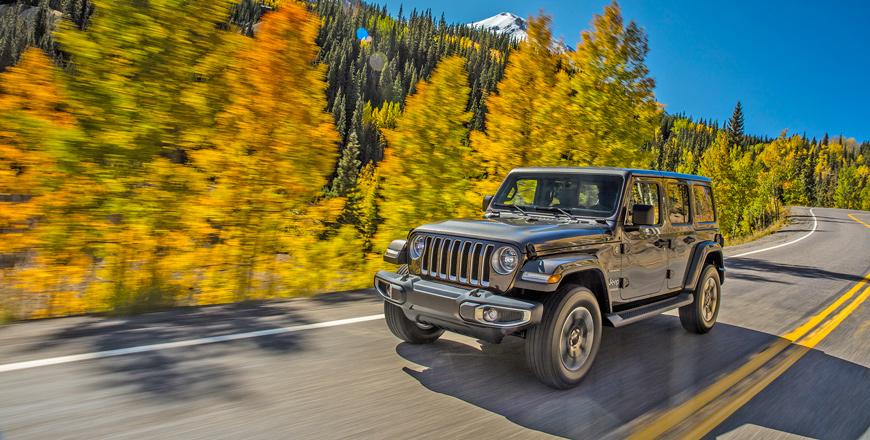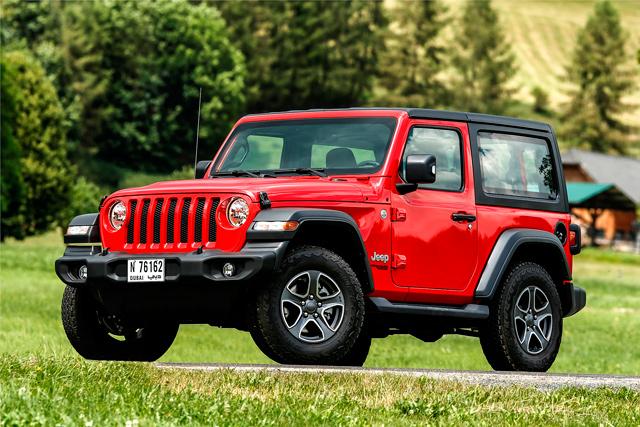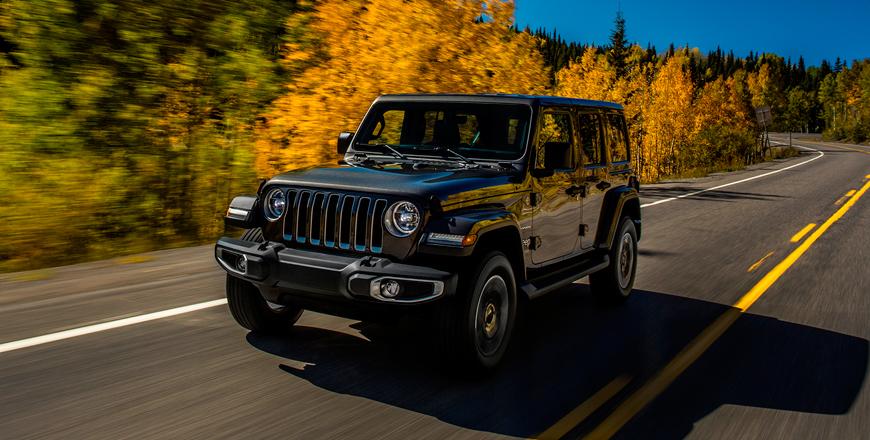You are here
Jeep Wrangler Sport 4-door: Family-friendly off-roader
By Ghaith Madadha - Sep 10,2018 - Last updated at Sep 10,2018

Photo courtesy of Jeep
The more sociable version of the Jeep Wrangler, the longer four-door model is a more spacious and family-friendly way to enjoy the most iconic of the off-roaders’ extensive abilities.
In its second generation being offered as a four-door SUV, the four-door Wrangler may not have the same classic proportions and may not be quite as manoeuvrable as the traditional two-door Wrangler, but its extra doors and length hugely broaden the appeal of the Wrangler as both an uncompromising off-road SUV and daily drive family car rolled into one.
Authentic aesthetic
Launched globally back in July as the latest “JL” incarnation of Jeep’s most capable and authentic models, the new Wrangler is a more comfortable, refined and practical daily driver, in both two- and four-door guises.
Uncompromisingly true to a deep off-roading heritage since the 1941 Willys Jeep military vehicle, the latest JL-generation Wrangler retains its traditional and rugged body-on-chassis construction, live axle suspension and off-road hardware.
Along with improved off-road abilities, it is crucially a far smoother drive with improved functionality, equipment, safety and handling for everyday use.
Immediately recognisable as a Wrangler with its traditional tapered in bonnet, wide, flat wheelarches and upright seven-slot grille, the new model makes a slight aesthetic concession to modernity with its grille being slightly swept back for improved aerodynamics.
Meanwhile its round headlights now slightly protrude in on the outside grille slots, like the 1944-86 “CJ” generation Jeep. A mildly more contemporary take on a classic shape, the “JL” Wrangler also features more modern square rear lights and, contrary to prevailing trends, a lower waistline and bigger glasshouse for better visibility.
Form and functionality
Gaining over half a metre in length almost entirely in wheelbase, the extended four-door model is fine looking, but may not be quite as aesthetically resolved, tidily packaged or urgent in posture as the two-door version.
It more than makes up for this with the added practicality of extra doors for easier rear access and features significantly improved rear legroom. Cargo capacity more than doubles from the two-door’s 203-litres with seats folded up to 548-litres for the four-door, and from 598-litres to 1,059-litres with rear seats folded down.
Slightly larger yet meaningfully lighter than the “JK” generation model it replaces, the “JL” Wrangler is available in three trim levels starting with the entry-level Sport, as driven, and the mechanically identical but more luxuriously equipped Sahara model, as pictured.
The third trim level is the off-road dedicated Rubicon, but all versions are equipped with the same naturally-aspirated 3.6-litre V6 Pentastar engine and smooth, slick and quick shifting 8-speed automatic gearbox across Middle East markets, including Jordan, where the US market’s turbocharged 2-litre hybrid model could have been a particularly popular choice given hybrid vehicle tax incentives.
Eager ability
Developing 281BHP at a somewhat high-revving 6,400rpm and 256lb/ft torque at 4,100rpm, the Wrangler’s Pentastar engine is smooth, responsive and eager. Keen off the line and with a generous and flexible mid-range, the Wrangler is willing and zealous to the redline, while its precise throttle control and progressive delivery allow one to unleash exact increments of power whether through on-road corners or driving through delicate off-road manoeuvres. Confident accelerating and versatile on the move, the Wrangler is capable of 177km/h and returns 9.7l/100km combined fuel efficiency, despite its upright design and 2,005kg weight.
Using rugged body-on-chassis construction with integrated rollover bars, the Wrangler is no soft-roader or half-hearted crossover. An authentic and capable off-roader, it is one of the few vehicles to employ front and rear live axles, and benefits from excellent 242mm ground clearance and 760mm water fording capability. Its short front and rear overhangs allow for generous 34.8 degree approach and 29.9 degree departure angles, but the longer four-door Wrangler’s 19.2 degree break-over angle is less than the two-door’s, which still makes it more capable than most SUVs.
The great outdoors
More refined, settled and smooth than expected of a body-on-chassis and all-round live axles design, if not quite as good as a Jeep Grand Cherokee on road, the four-door Wrangler’s longer wheelbase also makes it more stable and grippy on tarmac and dusty trails, if slightly less agile, nimble and manoeuvrable than the two-door on narrow roads.
Superb off-road, the Wrangler Sport and Sahara models feature Jeep’s Selec-Trac four-wheel-drive system with three high ratio driving modes for tarmac and less demanding off-roading, and can allocate power frontwards when necessary in Auto mode. Low range 4x4 mode delivers effortless mobility over difficult and demanding off-road routes.
Refined and ergonomic inside with improved design and materials, the “JL” Wrangler equipment list includes plenty of standard and optional modern safety, driver assistance, convenience and infotainment systems, including intuitive Uconnect infotainment system, and blind spot and rear cross-path detection.
Seating is upright and alert, and with a bigger glasshouse provides improved visibility. Offered with three roof options providing fully open air front and rear motoring, the Wrangler is available with electrically retractable Sky One-Touch soft-top, fully removable Zipperless Premium Sunrider soft-top, or removable three piece Freedom Top hard-top options, while removable doors and fold down windshield are now more user-friendly.
TECHNICAL SPECIFICATIONS
Engine: 3.6-litre, in-line, V6-cylinders
Bore x Stroke: 96 x 83mm
Compression ratio: 11.3:1
Valve-train: DOHC, 24-valve, variable timing
Gearbox: 8-speed automatic, four-wheel-drive, low ratio transfer
Gear ratios: 1st 4.714:1; 2nd 3.143:1; 3rd 2.106:1; 4th 1.667:1; 5th 1.285:1; 6th 1:1; 7th 0.839:1; 8th 0.667:1
Reverse/final drive: 3.295:1/4.45:1
Low ratio transfer/crawl ratios: 2.72:1/44.2:1
Power, BHP (PS) [kW]: 281 (285) [209] @6,400rpm
Specific power: 77.9BHP/litre
Power-to-weight: 148.3BHP/tonne
Torque, lb/ft (Nm): 256 (347) @4,100rpm
Specific torque: 96.2Nm/litre
Torque-to-weight: 183.2Nm/tonne
Top speed: 177km/h
Fuel consumption, urban/extra-urban/combined; 13-/7.8-/ 9.7-litres/100km
CO2 emissions, combined: 225g/km
Fuel capacity: 81-litres
Length: 4,882mm
Width: 1,894mm
Height: 1,881mm
Wheelbase: 3,008mm
Track: 1,598mm
Overhang, F/R: 741/1,036
Ground clearance: 242mm
Approach/break-over/departure angles: 34.8°/19.2°/29.9°
Water fording: 760mm
Seating: 5
Headroom, F/R: 1,036-1,083/1,023-1,059mm
Legroom, F/R: 1,038/974mm
Shoulder room, F/R: 1,417/1,417mm
Hip room, F/R: 1,370/1,140mm
Loading height: 762mm
Cargo volume min/max: 548-/1,059-litres
Kerb weight: 2,005kg
Weight distribution, F/R; 53 per cent/47 per cent
Payload: 564kg
Steering: Power-assisted rack & pinion
Steering ratio: 14.2:1
Lock-to-lock: 3.24-turns
Turning circle: 12.28-metres
Suspension: Solid axles, coil springs, anti-roll bars
Brakes, F/R: Ventilated disc, 330 x 24mm/disc, 328 x 12mm
Brake callipers, F/R: twin-/single-piston
Tyres: 245/75R17
Related Articles
The range-topping and off-road oriented version of what is already one of the best off-road vehicles money can buy, the Jeep Wrangler Rubico
The latest iteration of that most iconic of off-road vehicles, the all-new “JL” generation Jeep Wrangler is the most sophisticated and refin
Launched in 2018, the current “JL” generation of Jeep’s defining Wrangler model remains one of the most capable off-road vehicles to be foun














